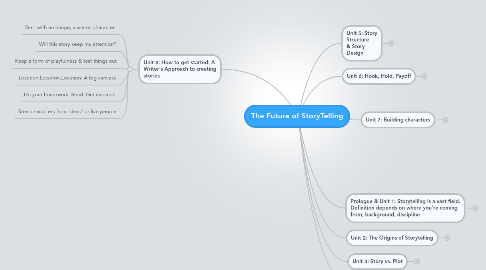
1. Unit 8: How to get started: A Writer's Approach to creating stories
1.1. Start with an image, a scene, character
1.2. Will this story keep my attention?
1.3. Keep a form of playfulness & test things out
1.4. Location.Location.Location: A big canvass
1.5. Do your homework. Read. Get inspired.
1.6. Steal characters from 'dead' or live people
2. Prologue & Unit 1: Storytelling is a vast field. Definition depends on where you're coming from, background, discipline
2.1. 1. What is Storytelling: It is about telling & story
2.2. 2. Definition depends on story, medium, and audience
2.2.1. Every writer should define it
2.2.1.1. A moment
2.2.1.2. Episodic
2.2.1.3. Audience defines a story
2.2.1.4. Uses language (film, dance, music)
2.2.1.5. Pieces of info, where delivery of it is controlled
2.3. 3. Modes of Operation of telling and story: structure, people, tools, elements, ideas
2.4. 4. Best storytellers know what's happening inside audience's head
2.4.1. Strategic gaps are left for audience to figure out
3. Unit 2: The Origins of Storytelling
3.1. Orality vs. Literacy
3.1.1. Oral: Episodic
3.1.2. Literacy: Story has beginning and end
3.2. 17th/18th Century stories
3.2.1. Introverted
3.2.2. Personal
3.2.3. First Stories: We are the Group (Epics)
3.2.4. My Stories (Bios)
3.3. 19th Century stories
3.3.1. "Quantity Effect"
3.3.1.1. More Variety
3.3.1.2. Fictional Prose
3.4. 20th Century Stories
3.4.1. "Destruction of Structure"
3.4.1.1. Nouveau Roman (Literature)
3.4.1.2. Film
3.5. Today's Stories
3.5.1. Biographical
3.6. Cultural Changes had influence how stories were told
3.6.1. New Tech has also led to New Content
3.6.1.1. Mediums like Web, Youtube increase SPREAD of stories, and rise of NEW content
4. Unit 3: Story vs. Plot
4.1. Story: Causal, chronological series of events
4.2. Plot: Order or duration of events as they're presented to us
4.3. David Bondwell's definition
4.3.1. Hitchcock's "The Man Who Knew Too Much"
5. Unit 4: Story Structure: Narrative Units
5.1. Beat
5.1.1. Number of actions at one place at a time
5.2. Scene
5.2.1. combination of Beats that leads to..
5.3. Sequence
5.4. Act
5.5. "Pretty Woman": 3 Acts: Meet, Lose, Get
5.6. Beginning, Middle, End: Expostion, Confrontation, Resolution
6. Unit 5: Story Structure & Story Design
6.1. Robert McKee's principles
6.1.1. Inciting Incident
6.1.2. Object of Desire
6.1.3. Pursuit of desire
6.1.4. Climax
6.1.5. Shaped in a progressive way
6.1.5.1. Hook. Hold. Payoff
6.2. Classical Design
6.2.1. Archplot
6.2.2. Antiplot
6.2.3. Miniplot
7. Unit 6: Hook, Hold, Payoff
7.1. Create an emotional impact
7.2. Immersive stories = Being in the moment
7.3. Hook: Identify protagonist
7.4. Hold: Protagonist/s and goal/desire struggle, goes through conflict--overcome or defeated by
7.5. Payoff: happy-ending, celebration
8. Unit 7: Building characters
8.1. Character shapes a story
8.2. Story shapes a character
8.3. Analyzing a story based on...
8.3.1. Who is character?
8.3.2. What does the character do?
8.3.3. Why is the character doing it?
8.4. Cornelia Funke on character building
8.4.1. Stories ask for a certain character
8.4.2. Character also moves a story
8.4.3. Prefers to be 'surprised' by characters of her story
8.4.4. Don't lead audience to familiar paths
8.4.5. Story should be a labyrinth

